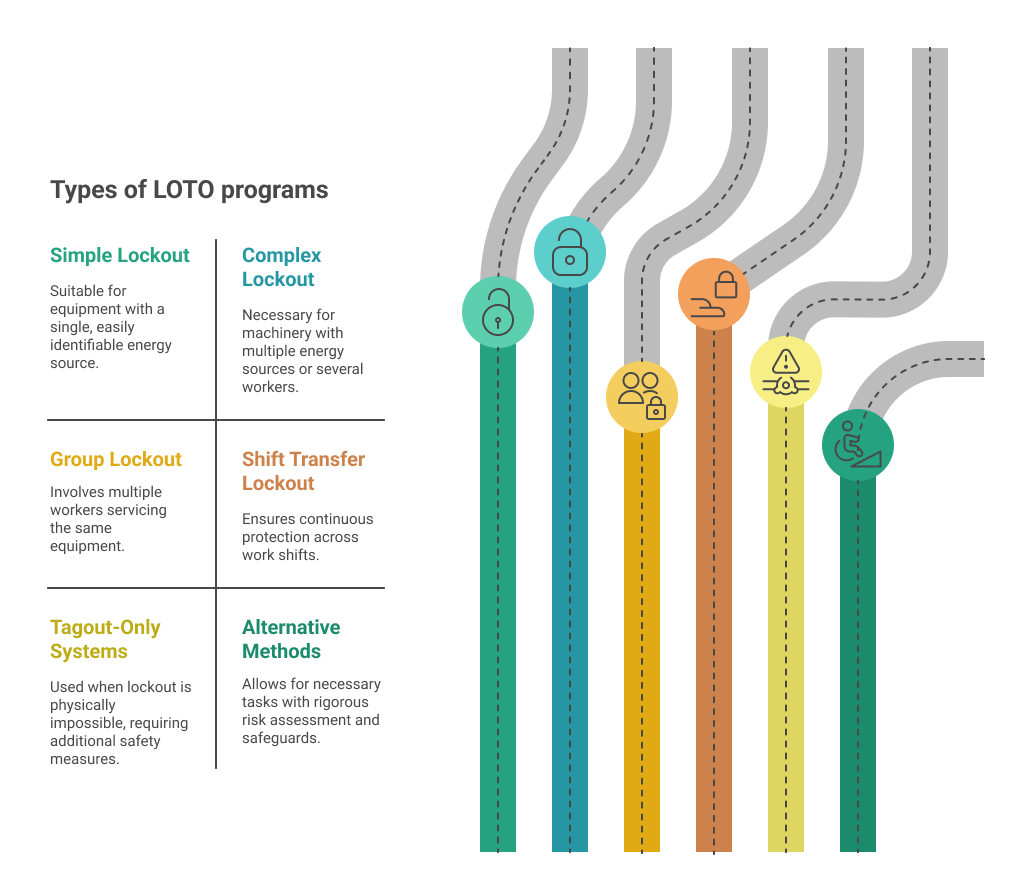What is LOTO (Lockout/Tagout)?
Lockout/Tagout (LOTO) refers to specific practices and procedures designed to protect workers from the unexpected energization or startup of machinery and equipment or the release of hazardous energy during service or maintenance activities.
Think of it as a safety system that ensures dangerous equipment is completely powered down and cannot be turned on while someone is working on it.
Preventing hazardous energy release is critical for any organization. Not following LOTO protocols can lead to severe accidents during routine activities like cleaning or lubricating equipment.
The term “lockout” refers to physically neutralizing an energy source by placing a lock on an energy-isolating device, effectively preventing the machine from being energized. The “tagout” component involves attaching a prominent warning tag to the locked device, indicating that it should not be operated until the tag is removed.
LOTO is mandated by OSHA (Occupational Safety and Health Administration) under standard 29 CFR 1910.147 for general industry. This regulation is often called “The Control of Hazardous Energy Standard.”
Hazards of Uncontrolled Energy Release
Uncontrolled energy release can have devastating consequences, leading to severe injuries or even fatalities for workers and others nearby.
Hazardous energy can manifest in various forms, such as electrical shock, burns, cuts, and other injuries. Imagine the sudden release of hydraulic pressure causing a hose to whip around violently or an unexpected electrical surge leading to a severe shock—these are just a few examples of the dangers of uncontrolled energy.
Beyond the immediate physical harm, uncontrolled energy release can also result in significant equipment damage, leading to costly downtime and lost productivity.
This affects businesses’ bottom lines and can result in hefty fines and penalties for non-compliance with OSHA regulations.
Employers are responsible for protecting workers from hazardous energy and ensuring a safe working environment. By implementing robust energy control procedures, employers can mitigate these risks and create a safer workplace for everyone.
Identifying Hazardous Energy Sources
Identifying hazardous energy sources is crucial in developing an effective energy control program. Hazardous energy can come from various sources, including electrical, mechanical, hydraulic, pneumatic, chemical, and thermal energy. Each of these energy sources poses unique risks and requires specific control measures.
Employers must conduct a thorough assessment to identify all hazardous energy sources present in the workplace. This includes the obvious sources, such as electrical power and hydraulic systems, and stored energy, like compressed air or hydraulic fluid, which can be released unexpectedly during maintenance or repair.
For instance, a spring under tension or a capacitor holding a charge can release energy suddenly if not properly controlled.
Employers can develop comprehensive energy control procedures that address each risk by identifying all potentially hazardous energy sources. This proactive approach is essential for protecting workers and ensuring compliance with safety regulations.
The LOTO Procedure: A Step-by-Step Guide
Let’s walk through the complete LOTO procedure, understanding why each step matters:
1. Preparation and Planning
Before any shutdown begins, all employees who might be affected need to be notified. This includes operators, area supervisors, and anyone using the equipment. Think of this as setting the stage for the maintenance work—everyone needs to know what’s happening to avoid confusion or dangerous situations.
2. Equipment Shutdown
The machine or equipment must be turned off using its normal stopping procedure. This might be as simple as pressing a stop button or following a more complex shutdown sequence. This step is like gradually bringing a car to a stop before turning off the engine—it prevents damage that might occur from an abrupt halt.
3. Isolation from Energy Sources
Here, you disconnect or separate the equipment from every energy source. This includes:
- Electrical power
- Hydraulic pressure
- Pneumatic pressure
- Mechanical energy (springs, elevated components)
- Thermal energy
- Chemical energy
Imagine this as cutting all lifelines to the machine—nothing can flow in to suddenly animate it.
4. Application of Lockout/Tagout Devices
This is the core of the LOTO procedure. After isolating energy sources, you physically lock them in the “off” or “safe” position using a lockout device, which secures energy-isolating devices to prevent machinery from being unintentionally energized during maintenance.
Each worker who will be performing service places their lock on each energy-isolating device. Think of this as everyone putting their own padlock on a gate—the gate cannot be opened unless every person removes their lock.
A tagout device also provides visual warnings and essential information about equipment status, ensuring safe working conditions.
Alongside each lock, a tag is attached that includes:
- Identity of the worker applying the lock
- Date and time applied
- Reason for the lockout
- Expected completion time
5. Control of Stored Energy
Residual or stored energy, such as water held behind a dam, must be recognized and addressed separately from the primary energy source when controlling hazardous energy. This step involves releasing or restraining this stored energy by:
- Venting pressurized fluids or gases
- Discharging capacitors
- Releasing or blocking springs
- Supporting or restraining elevated components
- Allowing hot parts to cool down
6. Verification of Isolation
Before work begins, test the equipment to ensure it’s truly de-energized. Try starting the machine using normal operating controls to confirm it won’t run. This verification step is similar to checking that a gun is unloaded before cleaning it—an essential safety measure.
7. Perform Service or Maintenance
With all safety measures in place, the planned work can now proceed.
8. Restoration Process
When the work is complete, and the equipment needs to be returned to service:
- Inspect the area to ensure all tools and parts are removed
- Verify all workers are safely positioned
- Notify all affected employees that locks will be removed
- Remove locks and tags (each worker removes their own lock)
- Re-energize the equipment
- Notify all affected employees that the equipment is back in service
This methodical restoration is like a pilot’s pre-flight checklist—every item must be verified before proceeding to the next step.

Energy Isolating Devices
Energy isolating devices are essential for controlling hazardous energy sources and preventing uncontrolled energy release. These devices physically disconnect or isolate energy sources, ensuring that machinery and equipment remain safe during maintenance or repair activities.

Examples of energy-isolating devices are circuit breakers, fuses, disconnect switches, and valves. Each device serves a specific purpose in controlling different types of hazardous energy. For instance, a disconnect switch can isolate electrical power, while a valve can control the flow of hydraulic or pneumatic energy.
Energy isolating devices must be appropriately designed and installed to be effective. Employers must also ensure these devices are regularly maintained and inspected to verify their functionality. A well-maintained energy isolating device is a critical component of an energy control program, providing a reliable means of controlling hazardous energy and protecting workers from potential harm.
Types of LOTO Programs and Procedures
Different situations call for different approaches to LOTO:
1. Simple Lockout
Used for equipment with a single energy source that can be easily identified and locked out. The procedure is straightforward—one person, lock, and energy source. This is like locking a single door to a room.
2. Complex Lockout
An energy control procedure is crucial for ensuring safe and effective lockout procedures for machinery with multiple energy sources or where several maintenance workers are involved. These situations require detailed procedures specific to each piece of equipment. Think of this as securing a building with many entrances, where each must be individually secured.
3. Group Lockout
A group lockout procedure may be used when multiple workers must service the same equipment. This often involves:
- A primary authorized employee who coordinates the LOTO procedure
- A group lockbox where the key(s) to the actual energy control lock(s) are placed
- Individual locks applied by each worker to the group lockbox
This creates a system where the equipment cannot be energized until every person has completed their work and removed their lock—similar to how a jury must have unanimous agreement.
4. Shift Transfer Lockout
When maintenance extends across different work shifts, specific procedures ensure continuous protection:
- Outgoing employees remove their locks
- Incoming employees apply their locks
- A designated transition period with supervisor oversight ensures no gaps in protection
Preventing hazardous energy releases during these transitions is crucial to avoid serious injuries and ensure compliance with Lockout/Tagout (LOTO) standards.
This is like a relay race where the baton (responsibility for safety) must be carefully passed without being dropped.
5. Tagout-Only Systems
Used only when Lockout is physically impossible. Since tags can be ignored or removed more easily than locks, additional safety measures must be implemented, such as:
- Removing circuit elements
- Blocking control switches
- Opening extra disconnects
- Removing valve handles
This is considered less secure than lockout and should be used only when necessary.
6. Alternative Methods
In certain limited situations where traditional LOTO would prevent the completion of necessary tasks (like testing or positioning equipment), documented alternative procedures may be developed. These require rigorous risk assessment and additional safeguards.

How CMMS Systems Enhance LOTO Safety Management
A Computerized Maintenance Management System (CMMS) like WorkTrek can transform organizations’ Lock Out/Tag Out (LOTO) processes, moving from potentially fragmented paper-based systems to a comprehensive digital approach. Let me explain how this works and why it matters for workplace safety.
Centralized Procedure Management
At its core, a CMMS creates a single source of truth for all LOTO procedures. Think of this as similar to how a library catalogs books—each piece of equipment gets its own “entry” containing:
- Step-by-step LOTO procedures specific to that equipment
- Visual aids showing energy isolation points (photos, diagrams)
- Required tools and PPE for safe isolation
- Verification steps to ensure zero energy state
This centralization means technicians always access the most current version of procedures, eliminating the risk of using outdated or incorrect methods. Imagine a hydraulic press modified last month—with a CMMS, the updated LOTO procedure is immediately available to all workers.
Integration with Work Management
The CMMS connects LOTO procedures directly to maintenance activities through work orders. This integration creates a safety-focused workflow:
- When a work order is created for equipment repair, the system automatically attaches the appropriate LOTO procedure
- Technicians must acknowledge the review of the procedure before proceeding
- The system captures digital signatures for LOTO application, and the removal
- Time stamps create an audit trail of the entire LOTO process
This integration means safety isn’t treated as separate from the work but becomes an integrated part of every maintenance activity.
Enhanced Compliance Management
OSHA requires regular review and documentation of LOTO procedures. A CMMS transforms this from a burdensome administrative task to an automated process:
- Schedules automatic reviews of LOTO procedures at required intervals
- Tracks employee LOTO training certifications and alerts when renewals are needed
- Generates compliance reports showing procedure updates, training status, and actual LOTO implementations
- Documents periodic LOTO audits with findings and corrective actions
When an OSHA inspector visits, all required documentation is immediately accessible rather than scattered across filing cabinets or individual computers.
Mobile Accessibility for Field Work
Modern CMMS systems like wOrkTrek extend LOTO management to where the work happens—in the field—through mobile applications:
When a maintenance technician approaches a piece of equipment, they can:
- Scan a QR code on the equipment to instantly access the correct LOTO procedure
- View clear isolation point images on their tablet or phone
- Document their LOTO implementation with photos
- Electronically notify affected employees about the lockout status
- Complete verification testing and document the results digitally
This accessibility helps ensure procedures are followed correctly even when supervisors aren’t present to oversee the work.
Risk Assessment and Continuous Improvement
The data captured in a CMMS creates opportunities for safety improvement:
- Identify equipment that requires frequent LOTO, suggesting potential redesign opportunities
- Track near-misses or incidents related to energy control
- Analyze LOTO procedure completion times to identify overly complex or problematic procedures
- Recognize patterns in procedure deviations that might indicate training gaps
Over time, this analytical capability helps organizations move from simply complying with regulations to proactively improving their energy control processes.
Group Lockout Coordination
For complex equipment requiring multiple technicians, a CMMS can coordinate group lockouts:
- Track all authorized employees involved in a particular LOTO event
- Document the primary authorized employee responsible for the group
- Record each lock application and removal
- Ensure all locks are accounted for before equipment is returned to service
This coordination is particularly valuable in facilities with complex energy systems or multiple contractors working simultaneously.
When implemented effectively, a CMMS like wOrkTrek transforms LOTO from an administrative burden to a comprehensive safety system that protects workers while creating the documentation needed for regulatory compliance. The digital approach improves safety outcomes and often increases efficiency by making procedures more accessible and reducing the time spent on paperwork.
Best Practices for Effective LOTO Implementation
To create a culture of safety around LOTO procedures:
Documentation and Training
- Develop written, equipment-specific LOTO procedures with diagrams identifying all energy sources and isolation points
- Train all employees who operate equipment (affected employees) and those who perform LOTO (authorized employees)
- Provide refresher training at least annually, and when procedures change
- Document all training with dates, content covered, and employee verification
This documentation creates a detailed map that anyone can follow to navigate hazardous terrain safely.
Equipment and Devices
- Use standardized, durable locks that withstand environmental conditions
- Implement a color-coding system for locks (e.g., different departments use different colors)
- Ensure each lock has only one key held by the worker applying the lock
- Use locks, tags, and energy control devices that identify the owner
- Regularly inspect and maintain LOTO devices
Energy control devices are crucial in managing hazardous energy within an energy control program, ensuring compliance with OSHA standards, and promoting workplace safety. Lockout devices are essential tools that prevent the energization of machinery and equipment, facilitating safe transitions during maintenance procedures.
Your LOTO equipment should be as reliable as the safety equipment used by mountain climbers—lives depend on it functioning correctly every time.
Program Management and Oversight
- Conduct periodic inspections (at least annually) to verify procedure effectiveness
- Maintain an inventory of all energy-isolating devices in the facility
- Create clear protocols for emergency lock removal (when the lock owner is unavailable)
- Establish contractor-specific LOTO procedures when outside workers are present
- Regularly audit and update procedures as equipment changes
Implementing hazardous energy control procedures is crucial for ensuring compliance with safety regulations.
These procedures, including Lockout/Tagout (LOTO) protocols, help manage and control hazardous energy sources, ensuring employees know the dangers and proper energy isolation and control techniques.
This oversight is like having regular health check-ups—identifying and addressing issues before they become serious problems.
Practical Implementation Tips
- Create visual aids showing lockout points for complex machinery
- Use lockout kits positioned near equipment for easy access
- Implement a check-in/check-out system for LOTO devices
- Consider electronic LOTO management systems for large facilities
- Develop simple visual indicators showing when equipment is under LOTO
- Create a system for identifying partially locked-out systems during complex maintenance
Adhering to safety standards to prevent hazardous energy exposure is crucial during normal production operations. While machine guarding is important, the OSHA lockout tagout standard takes precedence during ongoing production activities.
These practical elements help translate policy into practice, making it easier for workers to do the right thing.
Creating a Safety Culture Around LOTO
- Recognize and reward compliance with LOTO procedures
- Include LOTO in regular safety discussions and meetings
- Encourage reporting of near-misses or procedural gaps without fear of punishment
- Share lessons learned from incidents across the organization
- Involve workers in developing and improving LOTO procedures
When everyone understands not just how to follow LOTO procedures but why they matter, compliance becomes part of the workplace culture rather than just another rule to follow.
By understanding and implementing these comprehensive LOTO practices, organizations create a safer working environment where the risks associated with hazardous energy are effectively controlled. Remember that LOTO isn’t just about compliance with regulations—it’s about ensuring every worker returns home safely at the end of their shift.
Review, Audit, and Inspection of LOTO Programs
Regular review, audit, and inspection of LOTO programs are essential to ensure ongoing compliance with OSHA regulations and the effectiveness of energy control procedures. This process involves a comprehensive evaluation of the energy control program, including the procedures and training provided to employees.
Employers should inspect energy-isolating and tagout devices during the review to ensure they are properly installed and maintained. This step is crucial for identifying any potential weaknesses or deficiencies in the system.
The review process should be thoroughly documented, with records of findings and any corrective actions taken.
Employers must take prompt corrective action to address any issues identified during the review, audit, and inspection process.
This proactive approach helps to continuously improve the energy control program, ensuring that it remains effective in protecting workers from hazardous energy. By maintaining a robust review and audit process, employers can create a safer working environment and demonstrate their commitment to safety and compliance.
Get a Free WorkTrek Demo
Let's show you how WorkTrek can help you optimize your maintenance operation.
Try for free


